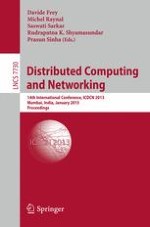This book constitutes the refereed proceedings of the 14th International Conference on Distributed Computing and Networking, ICDCN 2013, held in Mumbai, India, during January 3-6, 2013. The 27 revised full papers, 5 short papers presented together with 7 poster papers were carefully reviewed and selected from 149 submissions. The papers cover topics such as distributed algorithms and concurrent data structures; integration of heterogeneous wireless and wired networks; distributed operating systems; internetworking protocols and internet applications; distributed database systems; mobile and pervasive computing, context-aware distributed systems; embedded distributed systems; next generation and converged network architectures; experiments and performance evaluation of distributed systems; overlay and peer-to-peer networks and services; fault-tolerance, reliability, and availability; home networking and services; multiprocessor and multi-core architectures and algorithms; resource management and quality of service; self-organization, self-stabilization, and autonomic computing; network security and privacy; high performance computing, grid computing, and cloud computing; energy-efficient networking and smart grids; security, cryptography, and game theory in distributed systems; sensor, PAN and ad-hoc networks; and traffic engineering, pricing, network management.
